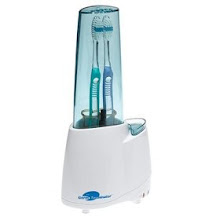Tuesday, January 15, 2008
Block Those Nasty Germs!
The toothbrush is used two to three times a day to remove dangerous germs and break up the bacteria-ridden plaque that causes gum disease, cavities, and chronic infections. Where do you think the germs go after we brush?
If you are not sanitizing your toothbrush already, the bacteria, viruses, fungi, rotting food particles, and parasites can remain on your toothbrush. They’re too small to be seen with the naked eye, but believe me, they are there. They are joined by other bugs from neighboring toothbrushes, dirty hands, coughs and sneezes, and germs from the aerosol spray dispersed in the air when the toilet is flushed in addition to anything else that may be airborne from the sewer line or ventilation ducts.
This group of germs then waits on the bristles of your trusty toothbrush to be transmitted to your bloodstream and then to vital organs and tissues through the cuts made in your gums the next time you brush. While blood may not appear in the sink every time you brush, you can be sure that every time you use a toothbrush, the bristles on your trusty brush can be making microscopic cuts in your gums. This can happen every time, whether you see the evidence in the sink or not.
This is a potentially dangerous process because the direct contamination through the cuts in the gums allows the germs to bypass the body’s natural immune defense mechanisms and go straight into the bloodstream. Simply put, all areas of the body can be affected by the presence of oral germ infections and all parts of the body can be negatively affected by chronic germs on toothbrush bristles.
By sanitizing our toothbrushes each time we brush, we provide no easy route for the toothbrush germs to make their way into our bloodstreams. In doing so, we favor the mouth germs that are actually good for us, and help eliminate the evolution of the bad ones.
It Just Makes Sense!
For more information, visit your website, www.germterminator.com
If you are not sanitizing your toothbrush already, the bacteria, viruses, fungi, rotting food particles, and parasites can remain on your toothbrush. They’re too small to be seen with the naked eye, but believe me, they are there. They are joined by other bugs from neighboring toothbrushes, dirty hands, coughs and sneezes, and germs from the aerosol spray dispersed in the air when the toilet is flushed in addition to anything else that may be airborne from the sewer line or ventilation ducts.
This group of germs then waits on the bristles of your trusty toothbrush to be transmitted to your bloodstream and then to vital organs and tissues through the cuts made in your gums the next time you brush. While blood may not appear in the sink every time you brush, you can be sure that every time you use a toothbrush, the bristles on your trusty brush can be making microscopic cuts in your gums. This can happen every time, whether you see the evidence in the sink or not.
This is a potentially dangerous process because the direct contamination through the cuts in the gums allows the germs to bypass the body’s natural immune defense mechanisms and go straight into the bloodstream. Simply put, all areas of the body can be affected by the presence of oral germ infections and all parts of the body can be negatively affected by chronic germs on toothbrush bristles.
By sanitizing our toothbrushes each time we brush, we provide no easy route for the toothbrush germs to make their way into our bloodstreams. In doing so, we favor the mouth germs that are actually good for us, and help eliminate the evolution of the bad ones.
It Just Makes Sense!
For more information, visit your website, www.germterminator.com
Subscribe to:
Comments (Atom)




